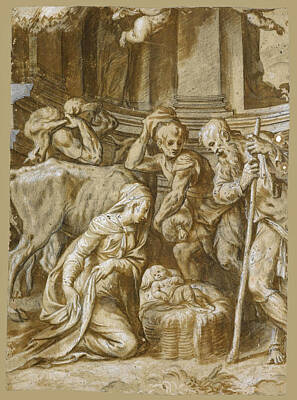Paolo Farinati
A Standing Soldier In A Niche Possibly Attalus I Of Pergamon
The Adoration Of The Shepherds
Elijah Brought To Heaven By A Chariot Of Fire
Paolo Farinati (also called as Farinato or Farinato degli Uberti; c. 1524 – c. 1606) was an Italian painter of the Mannerist style, active in mainly in his native Verona, but also in Mantua and Venice.
He may have ancestors among Florentine stock to which belonged the Ghibelline leader Farinata degli Uberti, celebrated in Dante's Divina Commedia. He was a contemporary of the prominent artist of Verona, Paolo Veronese. He was succeeded by other members of the Cagliari family, of whom most or all were outlived by Farinato. He was instructed, according to Giorgio Vasari, by his father and by the Veronese Niccolò Giolfino, and probably by Antonio Badile and Domenico del Riccio (Brusasorci).
Proceeding to Mantua, he formed his initial style partly on the influence of Giulio Romano. His first major work was an altarpiece for the Duomo of Mantua. The chapel of the Sacrament in that church was frescoed concurrently by Farinati, Paolo Veronese, Domenico Riccio, and Battista del Moro.[1]
Vasari praised his thronged compositions and merit of draughtsmanship. His works are to be found not only in Venice and principally in Verona, but also in Padua and other towns belonging or adjacent to the Venetian territory. Later, he accommodated to a style similar to that of Paolo Veronese.
He was a prosperous and light-hearted man, and continually progressed in his art, passing from a comparatively dry manner into a larger and bolder one, with much attraction of drapery and of landscape. The Miracle of the Loaves and Fishes, painted in the church of San Giorgio in Braida, is accounted his masterpiece, executed at the advanced age of seventy-nine, and crowded with figures. A Last Supper was painted by him in Santa Maria in Organo; also in this church, he painted a Michael expelling Lucifer and Massacre of the Innocents. In Piacenza is a St Sixtus; in Berlin a Presentation in the Temple; and in the communal gallery of Verona one of his masterpieces, the Marriage of St Catherine. Farinati executed some sculptures, and various etchings of sacred and mythologic subjects. He is said to have died at the same hour as his wife. His son Orazio was also a painter of merit. His daughter Chiara also was a painter.
Farinati is notable for having kept a detailed journal of his activities from 1573 until his death. His many drawings on tinted paper are particularly notable.
Presentation at temple
Baptism of Christ
Adoration of the Magi
Notes
Bernasconi, Cesare (1864). Painting Studi sopra la storia della pittura italiana dei secoli xiv e xv e della scuola pittorica veronese dai medi tempi fino tutto il secolo xviii. Googlebooks. p. 348.
References
Freedberg, Sydney J. (1993). Pelican History of Art, ed. Painting in Italy, 1500-1600. Penguin Books. p. 564.
This article incorporates text from a publication now in the public domain: Chisholm, Hugh, ed. (1911). "Farinato, Paolo". Encyclopædia Britannica (11th ed.). Cambridge University Press.
External links
Media related to Paolo Farinati at Wikimedia Commons Works related to Paolo Farinati at Wikisource
Catholic Encyclopedia (1913)/Paolo Farinato
Getty guide
----
Fine Art Prints | Greeting Cards | Phone Cases | Lifestyle | Face Masks | Men's , Women' Apparel | Home Decor | jigsaw puzzles | Notebooks | Tapestries | ...
----
Artist
A - B - C - D - E - F - G - H - I - J - K - L - M -
N - O - P - Q - R - S - T - U - V - W - X - Y - Z
Retrieved from "http://en.wikipedia.org/"
All text is available under the terms of the GNU Free Documentation License






